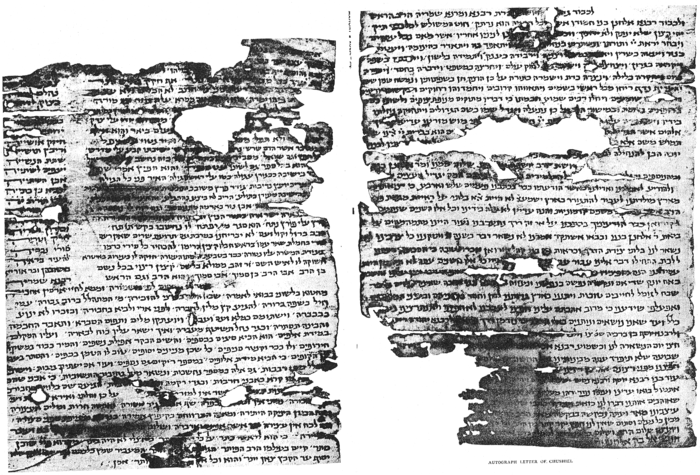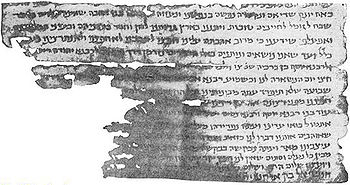- Chushiel
-
Chushiel ben Elchanan was president of the bet ha-midrash at Kairwan toward the end of the 10th century. He was born probably in Italy, but his origins and travels are obscure, and his eventual arrival in Kairwan is the subject of a well-known story.
Contents
The Story of the Four Prisoners
According to the Sefer Ha-Kabbalah of Abraham ibn Daud, Chushiel was one of the four scholars who were captured by Ibn Rumaḥis, an Arab admiral, while voyaging from Bari to Sebaste to collect money "for the dowries of poor brides." Ḥushiel was sold as a slave in North Africa, but he and the other three rabbis were ransomed by Jewish communities in Alexandria, Cordoba, and Kairouan. On being ransomed, Ḥushiel went to Kairouan, an ancient seat of Talmudical scholarship (Harkavy, Teshubot ha-Ge'onim, Nos. 199, 210). There his Talmudical knowledge gained for him the position of president of the bet ha-midrash (A. Neubauer, M. J. C. i. 67 et seq.)—probably after the death of Jacob ben Nissim.
However, an autograph letter from Ḥushiel (discovered in the Cairo Genizah and published by S. Schechter, J. Q. R. xi. 643) addressed to Shemariah ben Elhanan, chief rabbi of Cairo (supposed by Ibn Daud to have been captured with Ḥushiel), tends to show that Ḥushiel merely went to visit his friends in Middle Eastern countries, and was retained by the community of Kairouan. It may therefore be the case that the story presented by ibn Daud is an etiological myth explaining the migration of Jewish centers of learning from Babylonia to Spain and North Africa.
Origins
There is considerable difference of opinion in regard to Ḥushiel's nativity. H. Grätz, Harkavy, and D. Kaufmann claim that he, with the other three scholars, came from Babylonia, while S.J. Rapoport, I.H. Weiss, and Isaac Halévy give Italy as his birth-place. This latter opinion is confirmed by the wording of the above-mentioned letter, in which Ḥushiel speaks of having come from the country of the "'arelim," meaning "Christian" countries. According to another but unreliable source (Menahem Meïri's Bet ha-Beḥirha; see A. Neubauer in M. J. C. ii. 225), he came from Spain. Two of Ḥushiel's pupils were his son Hananeel and Nissim ben Jacob (see I.H. Weiss, Dor, iv. 265, note 1). According to the genizah letter, Ḥushiel seems to have had another son, named Elhanan, if "Elhanan" and "Hananeel" are not identical.
Works
It is not known whether Ḥushiel wrote any book, but a few of his sayings have been transmitted by his pupils. Thus Nissim ben Jacob reports in his Mafteaḥ (p. 13) that the story which the Talmud, without giving any particulars, mentions as having been related by R. Papa (Ber. 8b), was transmitted to him (Nissim) in full by Ḥushiel. Ḥushiel's son Hananeel quotes explanations in his father's name (see Aruk, s.v. ; Isaac ibn Ghayyat, Hilkot Lulab, ed. Bamberger, p. 113).
Ḥushiel was certainly one of the greatest, if not the greatest, of the Talmudical teachers of the 10th century, and Samuel ha-Nagid, recognizing his importance and value, ordered that memorial services in his honor should be celebrated in Granada, Lucena, and Córdoba. Samuel also wrote a letter of condolence to Ḥushiel's son Hananeel. This has been published by Firkovich in Ha-Karmel, viii. (Ha-Sharon, No. 31, p. 245), and in Berliner's Magazin, v. 70 et seq. (Oẓar Ṭob, p. 64), the German translation being by David Kaufmann. The letter, ending with a Hebrew poem in the Hazaj meter, and written in a very difficult style, praises Ḥushiel's knowledge and virtue, and compliments Hananeel.
Complete letter of Chushiel
Below is a scan of the complete letter of Chushiel, from S. Schechter (1899) in Jewish Quarterly Review 11:644-650. Schechter there also provides a transcript of the portions that are legible, accompanied by a brief analysis of the grammar and contents.

Jewish Encyclopedia bibliography
- Abraham Berliner, in Migdal Ḥananel, pp. v. et seq., xxviii. et seq., Leipsic, 1876;
- Heinrich Grätz, Gesch. v. 288, 289, note 21;
- Rabinowitz's Hebrew translation of Grätz, vol. iii., Index;
- Halberstam, in Berliner's Magazin, iii. 171;
- Isaac Halévy, Dorot ha-Rishonim, iii., ch. 35 et seq.;
- Adolf Neubauer, M. J. C. i. 67, 68, 73; ii. 225, 234;
- S.J. Rapoport, in Bikkure ha-'Ittim, xii. 11 et seq.;
- S. Schechter, in J. Q. R. xi. 643 et seq.;
- Isaac Hirsch Weiss, Dor, iv. 265;
- Winter and Wünsche, Die Jüdische Litteratur, ii. 357;
- Zunz, Ritus, p. 190.
External links
- http://www.isfsp.org/sages/daud.html
- http://www.chabad.org/library/article.asp?AID=111839
- http://www.ucalgary.ca/~elsegal/Shokel/060831_Pirates.html
- Jewish Encyclopedia article on Chushiel, by Solomon Schechter and Max Schloessinger.
This article incorporates text from the 1901–1906 Jewish Encyclopedia, a publication now in the public domain.
Categories:- 10th-century rabbis
- Geonim
- People from Kairouan
Wikimedia Foundation. 2010.

